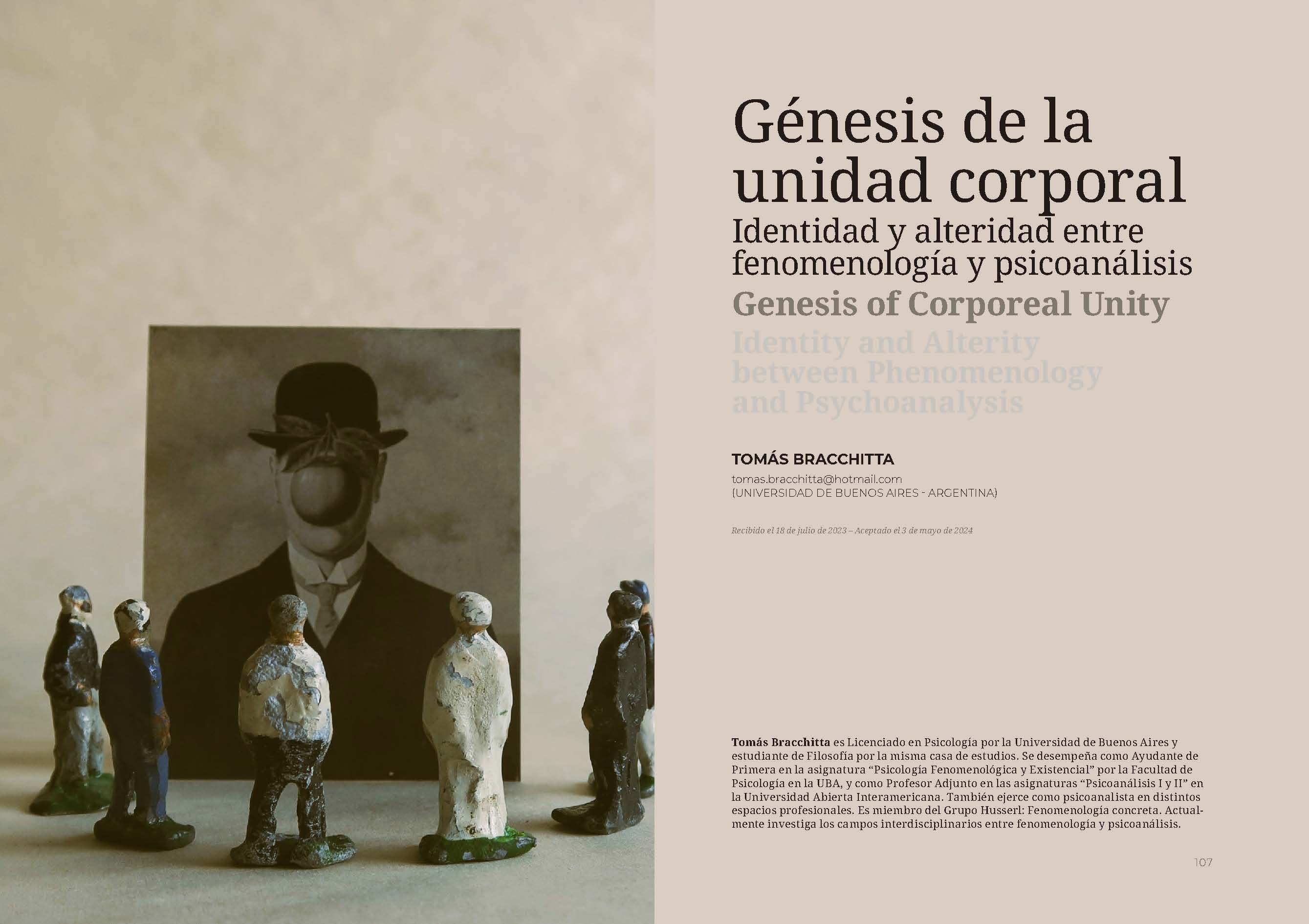Genesis of Corporeal Unity
Identity and Alterity between Phenomenology and Psychoanalysis
DOI:
https://doi.org/10.69498/ri.2024.20.463Keywords:
body, alterity, psychoanalysis, phenomenologyAbstract
The purpose of this paper is to explore the perception of the body as a unit and its relations with alterity. In order to accomplish this, we will draw upon the developments of phenomenology and psychoanalysis to address the constitution of the body as an object. In relation to phenomenology, Husserl proposes two dimensions of the body: the lived body (Leib) and the objective body (Körper). Although the body is perceived in everyday life as a unity, it presents an internal horizon. Merleau-Ponty builds upon Husserl's developments, conceiving the body as a habitual and temporal structure. This allows for the consideration of phenomena such as phantom limb syndrome, where the actual body does not coincide with the habitual body. Within psychoanalysis, Lacan introduces the mirror stage as the moment when the infant is able to recognize the body image in the mirror as their own, providing a dimension of unity where it did not exist. Simultaneously, this assumption enables the formation of the self and others. Consequently, various phenomena of distortion or alienation of the body image can be contemplated, such as certain phenomena of the hysteric body or verbal hallucination, as well as the discrepancy of the current image.
Within psychoanalysis, Lacan introduces the mirror stage as the moment when the infant is able to recognize the body image in the mirror as their own, providing a dimension of unity where it did not exist. Simultaneously, this assumption enables the formation of the self and others. Consequently, various phenomena of distortion or alienation of the body image can be contemplated, such as certain phenomena of the hysteric body or verbal hallucination, as well as the discrepancy of the current image.
Downloads
References
Freud, Sigmund, "Estudios sobre la histeria" en Sigmund Freud Obras completas II, Buenos Aires, Amorrortu editores, 1976.
---, "La interpretación de los sueños" en Sigmund Freud Obras completas IV, Buenos Aires, Amorrortu editores, 1976.
---, "Cinco conferencias sobre psicoanálisis" en Sigmund Freud Obras completas XI, Buenos Aires, Amorrortu editores, 1976.
Husserl, Edmund, Lecciones de fenomenología de la conciencia interna del tiempo, trad. Agustín Serrano de Haro, Madrid, Trotta, 2002.
---, Ideas relativas a una fenomenología pura y una filosofía fenomenológica. Libro segundo: Investigaciones fenomenológicas sobre la constitución, trad. Antonio Zirión Quijano, México, FCE, 2005.
---, "Método fenomenológico estático y genético (1921)", trad. Ignacio Quepons Ramírez, en Acta Mexicana de Fenomenología, vol. 3, Abril 2018, pp. 117- 125.
Karothy, Rolando H., El niño, el espejo y la mirada, Buenos Aires, Lazos, 2019.
Lacan, Jacques, El seminario. Libro 3: Las psicosis, Buenos Aires, Paidós, 1984.
---, "El estadio del espejo como formador de la función del yo tal como se nos revela en la experiencia psicoanalítica" en Escritos, Tomo I, México, Siglo XXI, 2014, pp. 99-105.
---, "La agresividad en psicoanálisis" en Escritos, Tomo I, México, Siglo XXI, 2014, pp. 107-127.
---, "Acerca de la causalidad psíquica" en Escritos, Tomo I, México, Siglo XXI, 2014, pp. 151-190.
--- ,"El tiempo lógico y el aserto de servidumbre anticipada" en Escritos, Tomo I. México, Siglo XXI, 2014, pp. 193-208.
Merleau-Ponty, Maurice. Fenomenología de la percepción, trad. Jem Cabanes, Barcelona, Planeta Agostini, 1985.
---, Las relaciones del niño con los otros, trad. Irma B. Bocchino de González, Córdoba, Universidad Nacional de Córdoba, 1951.
Osswald, Andrés M., "El concepto de pasividad en Edmund Husserl" en Areté. Revista de Filosofía, vol. XXVI, n° 1, 2014, pp. 33-51

Downloads
Published
How to Cite
Issue
Section
License
Copyright (c) 2023 Tomas Bracchitta

This work is licensed under a Creative Commons Attribution-NonCommercial-ShareAlike 4.0 International License.








